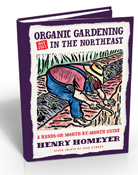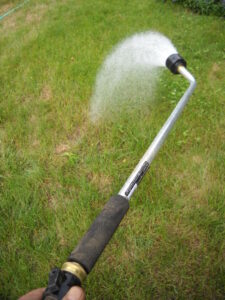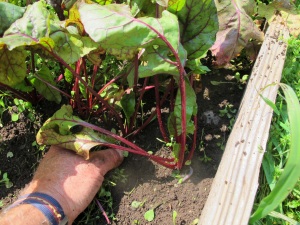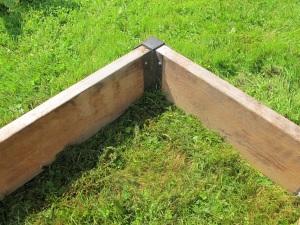Spring Has Sprung!
It’s April, and spring has sprung. Or will soon. Winter always is a sneaky devil, coming back with hard frosts and even a foot of snow on occasion. There is much to do, but start slowly – not just for your back, which has been resting all winter, but because a week of warm sunny days doesn’t mean your soil is warm enough to plant. A soil thermometer pushed 3 inches into the soil should read 50 degrees before planting anything – even spinach and so called cold weather crops.
I recommend raised beds for the vegetable garden, but you don’t have to build or buy wooden boxes for raised beds. When the soil has dried out, loosen it with a garden fork, and then use a short-tined rake to drag soil from walkways onto your designated beds to raise them up six inches or so. A 30-inch wide bed is ideal, it’s wide enough for roots to spread far and wide, yet you will be able to reach all parts for weeding.
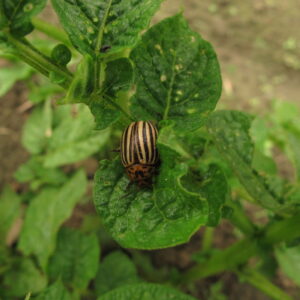 Organic seed producers have to deliver seeds for plants that will not be protected from diseases and pests with chemicals. They have to tough. Lastly, buying organic seeds and plants supports organic farmers. They are working hard to protect the environment by avoiding chemicals. Pay a little bit more if you can, and buy organic.
Organic seed producers have to deliver seeds for plants that will not be protected from diseases and pests with chemicals. They have to tough. Lastly, buying organic seeds and plants supports organic farmers. They are working hard to protect the environment by avoiding chemicals. Pay a little bit more if you can, and buy organic.Vegetable Gardening
Certainly the weather is, year after year, a source of much consternation for gardeners. It’s too dry! (May). It’s too wet! (June). It’s too hot! Too cold! People seem to be delighted to complain about the weather. Me? I’m generally pleased by it all. What curve ball will Mother Nature throw at us next?
Despite the yearly weather variations, some things in the garden never change. We must thin our root crops, pull weeds, mulch. We need to pick off potato bugs on our plants, and remove their orange egg masses on the underneath sides of the leaves. We need to pick slugs and snails on the cool, moist days.
One of the most tedious jobs in the vegetable garden is thinning. Baby beets crowd each other, no matter how carefully we planted them. Carrots compete with their brothers and sisters for light, water and soil nutrients. It’s time to get down on your knees and get to work, thinning.
I was recently talking to a gardener who starts her beets indoors in flats in March or April, and then divides them up and plants them individually, properly spaced. Hmm. That would certainly eliminate the thinning problem. I’ll have to try that next year.
Carrots seeds are tiny, so spacing them well at planting time is difficult and time consuming. By now, carrots should be an inch apart. Later, by the end of July, carrots need more space – but the thinnings can be eaten, a reward I relish.
Some years ago I saw prize-winning carrots that were 18 inches long on display at the Tunbridge World’s Fair in Tunbridge, VT. I was flabbergasted. I made note of the grower’s name and tracked him down. He is Joey Klein, an organic gardener in Plainfield, VT with a farm on the Winooski River. He gave me good tips on how to grow long carrots, and they worked. You can start a new bed of carrots now for fall eating and storage.
Joey grows carrots in wide raised beds, each bed about 36 inches wide and mounded up about 6 inches above the walkways. He adds lots of organic matter to the soil, especially good, mature compost. He likes to say that he harvests sunshine. His carrots and broccoli turn sunshine into food. The soil he started with was good alluvial soil that has good drainage and texture – and few rocks, a bonus for anyone who wants long, straight carrots.
If you want long luscious carrots, buy a variety that is destined to be long. Joey uses “Sugarsnax 54” from Johnny’s Selected Seeds. I use seed from Renee’s Garden Seeds, a package of mixed orange and yellow carrots called “Sunshine Orange and Yellow” that gives me huge, long carrots, especially the yellows. Mine are not as long as Joey Klein’s, but are routinely 12 inches long.
I find growing long carrots in a wood-sided raised bed with 8-inch sides allows me to create a custom soil just right for carrots. I use a 50-50 mix of topsoil and compost, mixing my garden soil with compost I buy from a local guy who buys cow barn waste and turns it into light, fluffy compost. A box 40 inches wide will grow 3 rows of carrots separated by 15 inches and with 5 inches of space from the walls.
If you are not handy with tools, Gardeners Supply Co (www.gardeners.com or 888-833-1412) sells metal corners that will help you to assemble a nice bed in just a few minutes. Their raised bed corners are sturdy and square, and all you have to do is slide in the 2-by-8’s and screw the lumber in place (a screwgun helps make that job easy).
You can set the box you build right on your lawn, fill it up and plant! The lawn will die where you place your bed, and by the second year carrots will grow right down into the soil beneath the bed (the first year, they may grow down to the lawn, then turn sideways). Raised beds are great for rainy summers, as they drain well.
To get those big carrots, keep the soil well watered in dry times. Sprinkle some organic fertilizer in the row when you plant, and again 6 weeks later. That second application should be alongside the carrots; scratch it into the soil with a hand tool. Keep out weeds, and thin the seedlings as mentioned above.
Elsewhere in the garden I have removed the row covers from my cukes, zucchini and winter squash. I cover them to keep off the striped cucumber beetles off the young plants, but now the plants are big enough to survive some munching by beetles. When the blossom appear they need pollination by insects in order to produce fruit.
By the way, vine crops like zucchini produce flowers that are either male or female, and the boys appear first. So don’t despair if you don’t get any zukes at first. The ladies will be on their way soon.
We need to visit our vegetable gardens every day – and do a few acts of service for our plants. If we keep up with it all, we are deemed good gardeners and will, most likely, be rewarded with a bountiful harvest.
Henry can be reached at P.O. Box 364, Cornish Flat, NH 03746. Please include a self-addressed stamped envelope if you want a reply. Or e-mail him at henry.homeyer@comcast.net.

